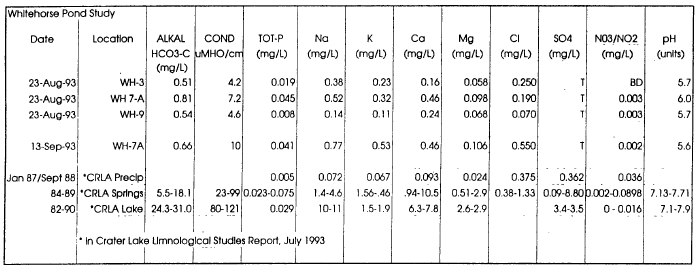August 21, 1993, Fourth Trip
The author was accompanied by Mr. David Hartesveldt and Mr. Larry Beard and family on this field trip. The Beards and the author worked together to sample the ponds for chemical and biological specimen as well as physical and chemical parameters. Mr. Hartesveldt crisscrossed the Bluff several times observing the flora in and around the ponds.
The tour began at Pond #7C. Pollywogs were noted in great numbers. They had bodies about one centimeter in diameter and tails of about 2.5 cm. They also had external gills. A zooplankton tow was completed on the pond’s surface. The pH was measured at 5.98 at 15.10 C at 1150 hours. The depth of the pond was 35 cm. Several egg clusters were seen on the shore with 50 or more 0.5 mm eggs per cluster.
Pond #7A had about 80 cm of water in it with a pH of 6.20 at a temperature of 13.20 C. There were two types of pollywogs in this pond, the first type had external gills and the other had no external gills. This second pollywog was round with a white belly and iridescent. A pond sample was taken from this pond for chemical nutrient analyses at CCAL (Table 3).
Pond #6 was observed. It was turbid and about 12 cm deep. There were few pollywogs in this pond. It appeared to be drying fast.
Pond #4 was grass covered and had one centimeter long dark toads all around it. These toads numbered about 30/m2. What water there was looked turbid. The bank was covered with elk tracks in the wet mud.
|
Table 3. Chemical Concentrations for Several Whitehorse Ponds. |
Pond #3 was 18.30 C and had a pH of 5.56. There were water striders and dragon flies at this pond. A chemistry nutrient sample was taken for CCAL. The pond was 95%exposed to direct sunlight. Grass was found high out of the water, under the water, and rooted at the bottom of the pond but floating on the surface. There were young salamanders with all four legs and about 8 cm long. An 8 to 10 cm frog was found. It had blue ear areas. This pond measured 60 cm deep and the bottom was covered with rocks and branches.
Pond #2 was 70% shaded and had a temperature of 17.40 C and a pH of 5.55. The pond was tea colored. Salamander pollywogs with external gills were observed.
Pond #5 was passed and was discovered to be dry on this date.
Ponds #MA and B were discovered to be dry and covered with moss. This made a very soft bed on which to lie.
Pond #9 was sampled for chemistry nutrient analyses for CCAL. It had salamander pollywogs which were 5 cm long. There were other salamander pollywogs evident with external gills. The temperature was 22.30 C and the pH was 5.59.
Pond #9 East or Pond #13 had shrimp and was very dark in color. The temperature was 22.0° C and the pH was 5.55.
September 10, 1993, Fifth Trip
We expected that at some time the ponds would be dry. On this field day all ponds were quickly visited and found to be dry except Pond #7A and D, and Pond #1. The ponds were visited between 1540 and 1810 hours. The temperature of Pond #7a was 23.50 C, pH was 5.92, and the dissolved oxygen concentration was 7.29 mg/L. A chemistry nutrient sample was taken for CCAL. A zooplankton tow was completed at Pond #7D. Although there was no water, there was an elk wallo in Pond #12.


